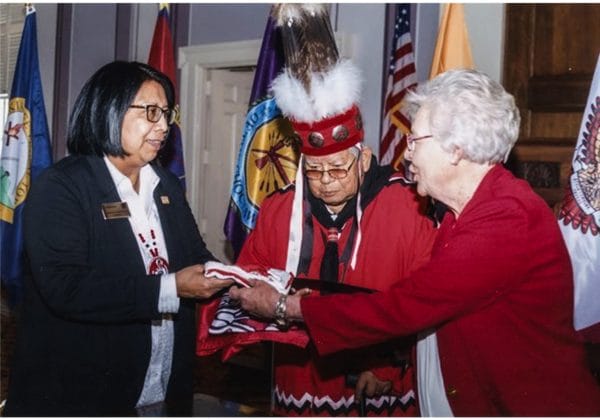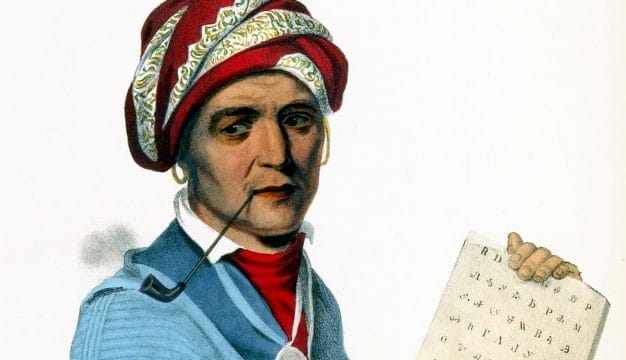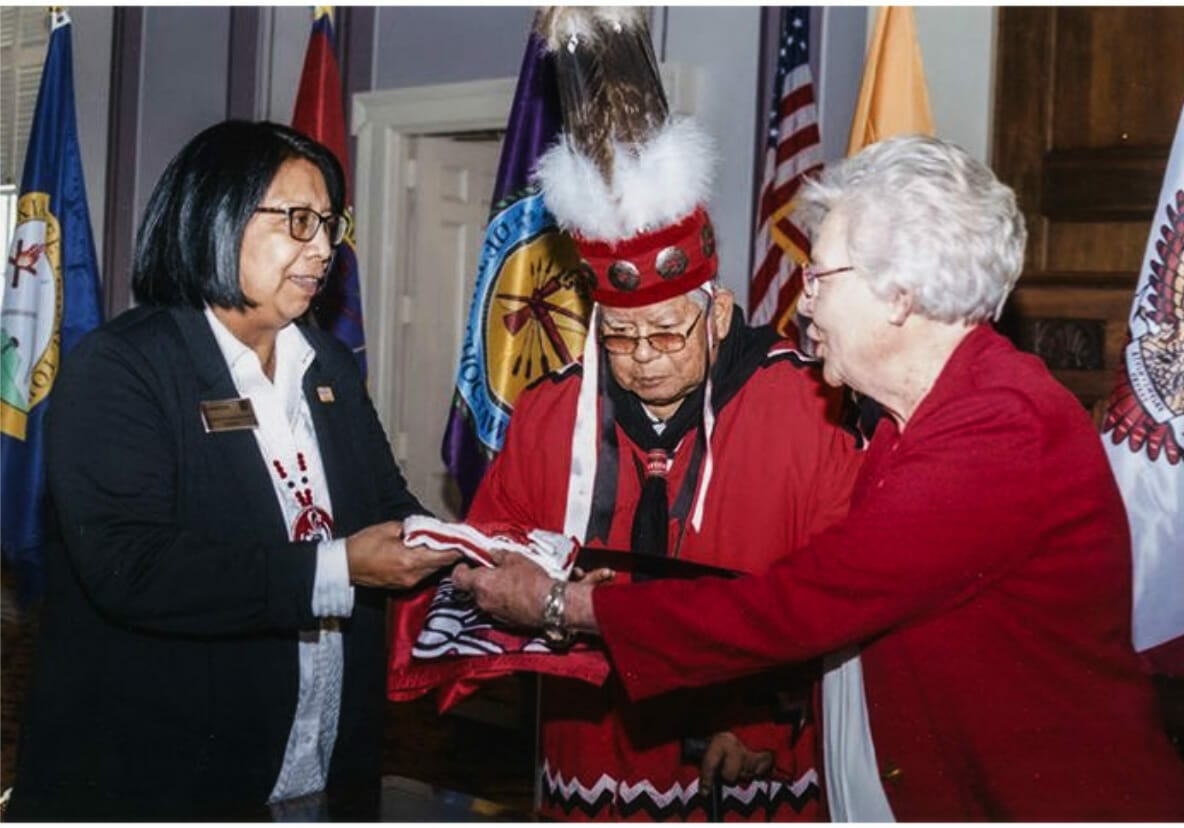Alabama-Coushattas in Alabama
Emerging from the scattered remnants of the once-powerful chiefdoms of the Mississippian period, the Alabama and Coushatta Indian tribes united in what is now central Alabama more than three centuries ago. Despite generations of contact with the Spanish, French, English, and eventually Americans, they maintained their cultural identity in the face of disease, dislocation, and depopulation by moving west. By 1800, most members of the Alabama-Coushatta were living west of the Mississippi River and currently live on tribal lands outside Livingston, in Polk County, Texas.
Like many southeastern tribes, both the Alabamas and Coushattas descended from the Native Americans of the Mississippian period, which existed from about AD 800-1500. They both speak closely related languages in the Muskhogean language family. The Alabamas were once part of the Moundville chiefdom located in western Alabama and eastern Mississippi, whereas the Coushattas were connected with the Coste chiefdom, located near Bussell Island in present-day eastern Tennessee.
According to their tribal folklore, the ancestors of the two groups travelled deep beneath the Earth before reaching the surface. After much time had passed, they surfaced at the opposite ends of a tree’s roots, and once they saw the light of day, their ancestors discovered the great Alabama River. The emerging Alabamas and Coushattas established their villages in two bodies.
After a brief encounter with Spanish conquistador Hernando de Soto in the early 1540s, both tribes felt the full impact of European contact. Soto and his men devastated many towns, took slaves, and spread European diseases, for which the tribes had no immunity. Further depopulation quickly followed and left both groups vulnerable to attack from the neighboring Chickasaws to the west and the Cherokees to the north and east. Survivors scattered and began another exodus from their ancient homelands in order to escape these calamities.
In the decades after Soto’s travels, the Alabamas and Coushattas came together, as a result of migrations, in central Alabama near present-day Montgomery. By 1686, Spanish explorer Marcos Delgado noted that Alabama and Coushatta refugees had established towns and villages along protective bluffs where the Alabama, Coosa, and Tallapoosa Rivers converge, just northeast of Montgomery. The new environment afforded an abundance of game and fertile soil for their crops, and their tribal names reflected their relationship to this new land. In the Alabama language, “Alabama” means “vegetation gatherers,” and in the Coushatta language (known as Koasati), “Coushatta” means “white cane.” Both names illustrate the environment in which the Alabamas and Coushattas lived and worked in the seventeenth and eighteenth centuries.
By 1700, the Alabamas and Coushattas had built a prosperous, tightly knit community in central Alabama. Each town was autonomous and ruled by a miko, or headman (usually referred to as a chief in the nineteenth century), a council of elders, and a war chief. Alabama and Coushatta society drew strength, stability, and cohesion through intermarriage, creating extensive kinship ties. Bound by these alliances, Alabama and Coushatta towns came to be known by Europeans as the Alabama Nation throughout most of the eighteenth century.
The Alabama Nation presented a united front when English and French explorers and then settlers eventually made their way into Alabama in the first half of the eighteenth century. The tribes’ strategic location at the river junctions proved to be a source of strength when negotiating with Europeans interested in trade. Alabama and Coushatta leaders also created flexible alliances with neighboring towns, many of them Creek, in order to promote their importance and sovereignty in central Alabama. French and British emissaries subsequently vied for the Alabama Nation’s allegiance. Like many other southeastern tribes, the Alabamas and Coushattas encouraged European rivalries by pursuing neutrality and consequently received gifts, trade, and protection from both French and English representatives seeking their favor.
Alabama and Coushatta townspeople solidified their importance in the Southeast by inviting the French to build a trading post and fort in the heart of their territory. With the help of Alabama labor, by 1717 the French had constructed Fort Toulouse, also known as Fort des Alibamons and aux Alibamons. The Alabama Nation helped control and maintain Fort Toulouse, which became a new center of trade and diplomacy. The close proximity of the French garrison to Alabama and Coushatta towns provided frequent contact, and intermarriage between the two cultures soon resulted. These new connections with the French altered Alabama and Coushatta culture as they came to rely more heavily on European trade goods. Despite these changes, children of Alabama and Coushatta women and French men were raised according to matrilineal tradition, which included assuming the mother’s clan membership.
Their kinship ties to the French created a difficult situation for the Alabamas and Coushattas as French control of the Southeast began to weaken, especially in the years leading to the French and Indian War (1754-63). During the conflict, the Alabama Nation, like other neighboring Indian groups, tried to remain neutral in order to reap the rewards of the competition between France and Britain. Some members of both tribes actively supported the French, however, and aided the garrison at Fort Toulouse. After the British victory, the French abandoned Fort Toulouse, resulting in a steady decline in Alabama-Coushatta control in central Alabama. By 1800, the majority of Alabamas and Coushattas had migrated west to Louisiana with many of their French kinsmen. For at least two decades they prospered by farming and hunting buffalo, bear, and deer, but continuous American encroachment and increased hostilities between the two cultures forced the Alabamas and Coushattas to relocate further west and rebuild their community in present-day southeast Texas.
By the mid-nineteenth century the two tribes again faced mounting pressure from settlers and continued to suffer depopulation and extreme hardship. In 1853, Chief Antone of the Alabamas negotiated with Sam Houston and other Texas officials and gained a permanent title to land in east Texas. By 1862, most Coushattas had joined their kinspeople on the Alabama reserve. The official allocation of 1,100 acres was minuscule compared with the territory they had occupied and claimed for generations in Alabama, Louisiana, and Texas. Yet the Alabamas and Coushattas both survived as an independent people and avoided forced removal to Oklahoma—the eventual fate of most Southeastern tribes—through skillful leadership, savvy negotiating, and flexibility. Today, there are three federally recognized Alabama-Coushatta communities: the Alabama-Coushatta Tribe of Texas, the Coushatta Tribe of Louisiana, and the Alabama-Quassarte Tribal Town in Oklahoma.
Further Reading
- Ethridge, Robbie, and Sheri M. Shuck-Hall. Mapping the Mississippian Shatter Zone: The Colonial Indian Slave Trade and Regional Instability in the American South. Lincoln: University of Nebraska Press, 2009.
- Hook, Jonathan. The Alabama-Coushatta Indians. College Station: Texas A&M University Press, 1998.
- Shuck-Hall, Sheri Marie. Journey to the West: The Alabama and Coushatta Indians. Norman: University of Oklahoma Press, 2008.






